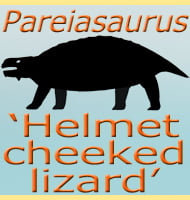In Depth
Placochelys was one of the more turtle-like members of the Placodontia, although its feet were not dedicated flippers and still retained toes suggesting that Placochelys may have occasionally ventured onto land. Aside from the development of a shell, Placochelys differed from earlier placodonts such as Placodus and Paraplacodus in that it had lost the teeth that pointed forwards out of the mouth in earlier forms. Instead Placochelys had a beak like structure that would have been just as capable as the specialised earlier teeth at picking up shellfish off the sea floor. Placochelys still had the more robust teeth at the back of the mouth and on the palate that would have allowed it to crush and break up shellfish to get at the soft body within.
Further Reading
– �ber Placochelys ng und ihre Beeutung fur die Stammesgeschichte der Schildkr�ten: Neues Jahrbuch fur Mineralogie. – Geologie und Pal�ontologie, Abhandlungen, 1902: 127-144. – O. Jaekel – 1902. – The Cranial Anatomy of Placochelys placodonta Jaekel, 1902, And a Review of the Cyamodontoidea (reptile, Placodonta) Fieldiana. – Geology, New Series, No. 45: 1-101. – Olivier Rieppel – 2001.










